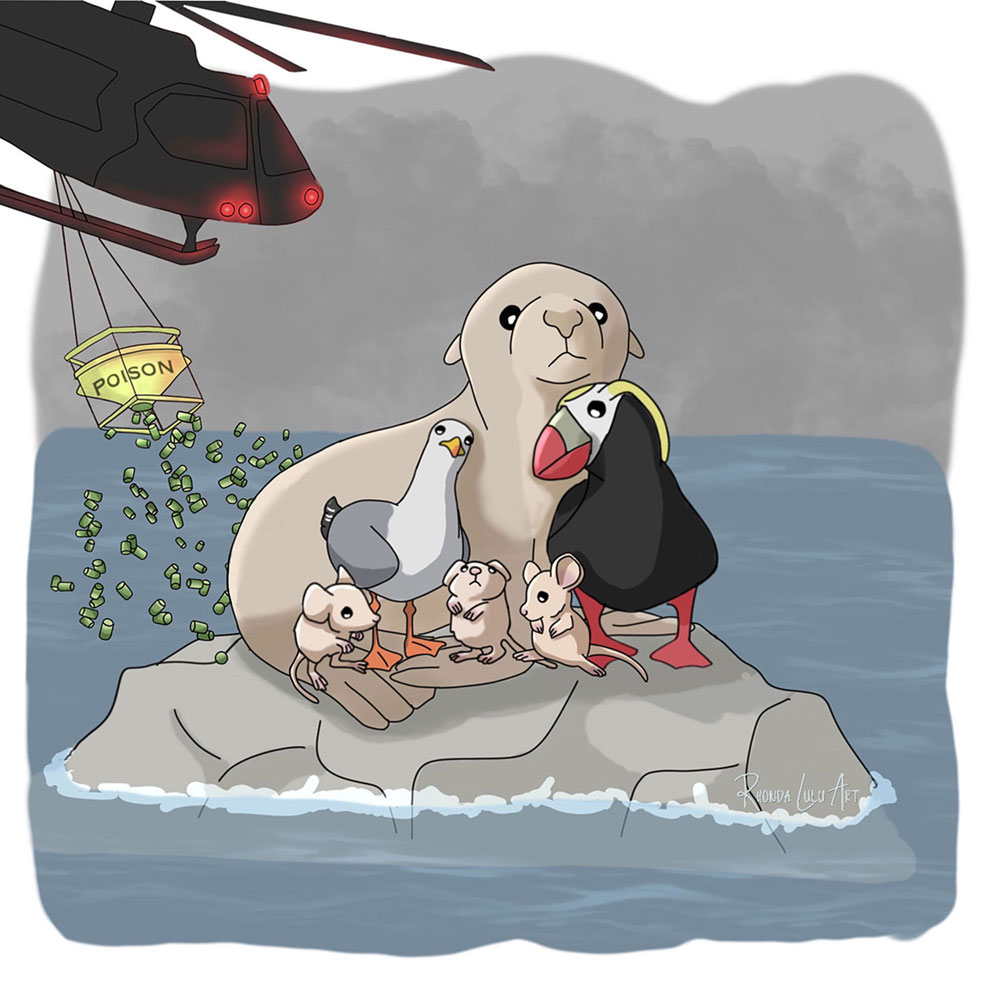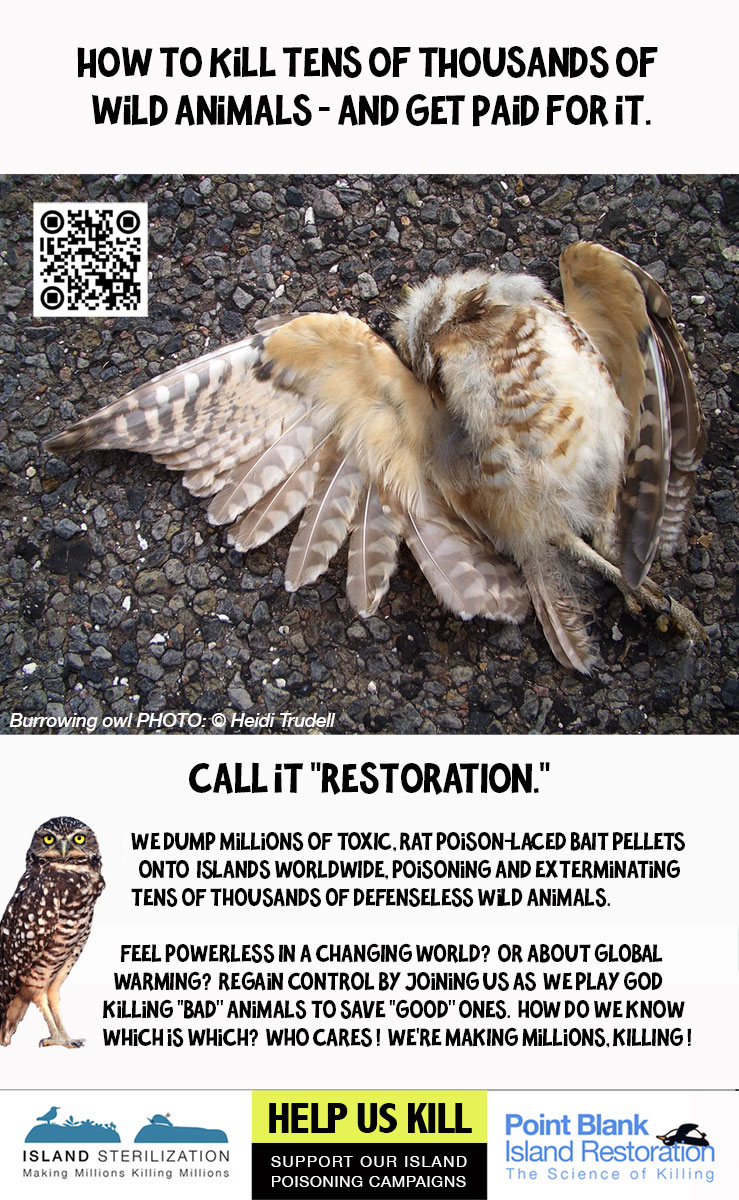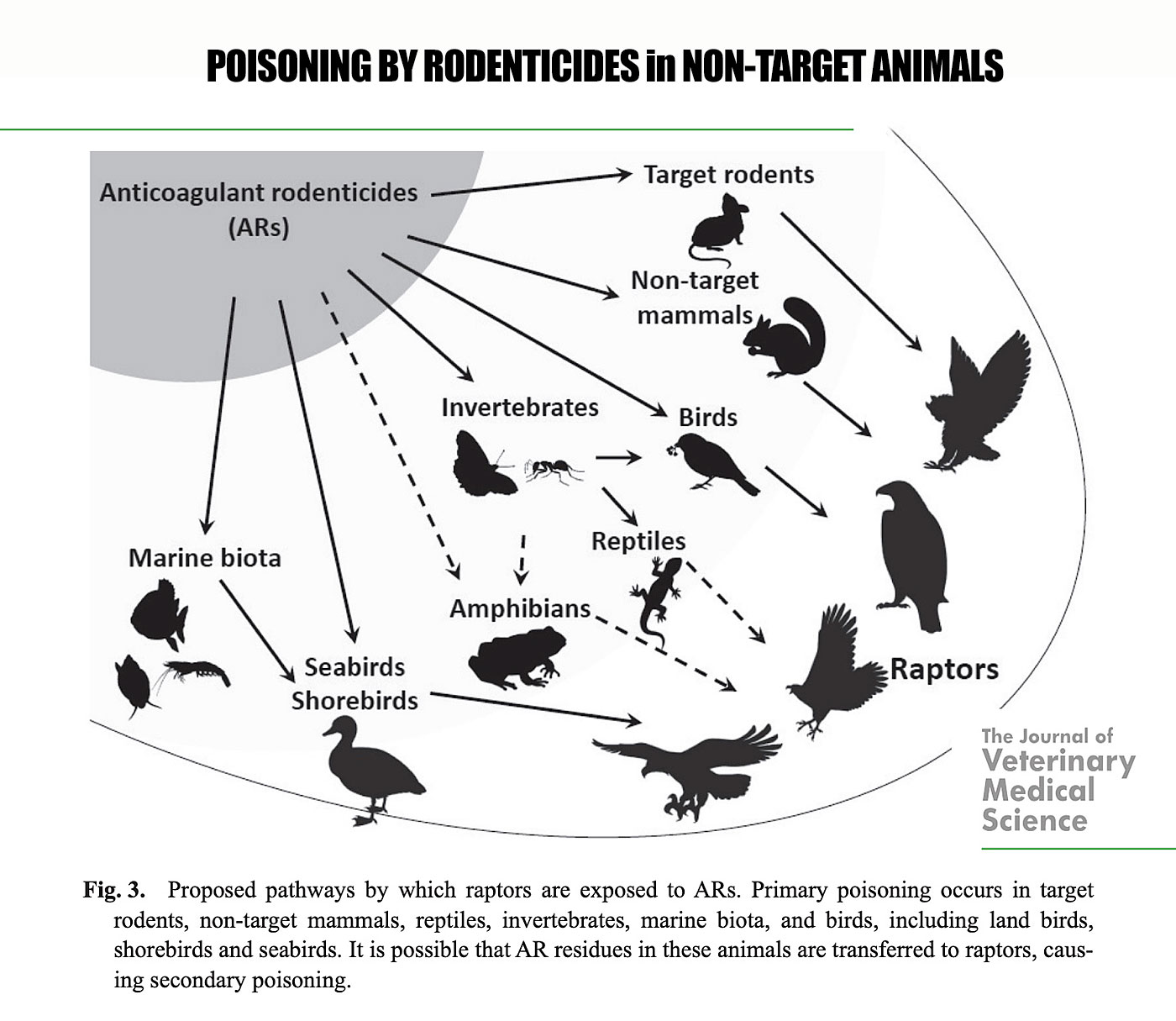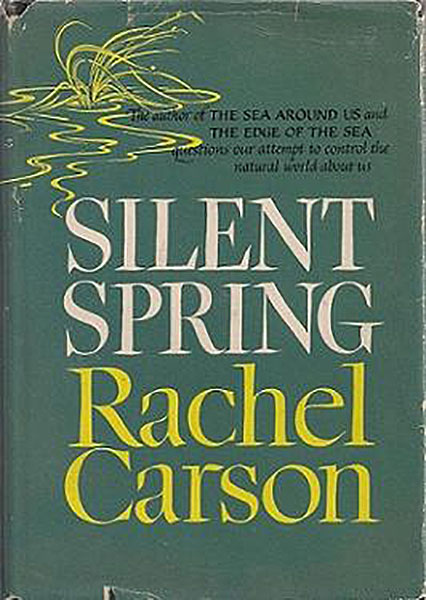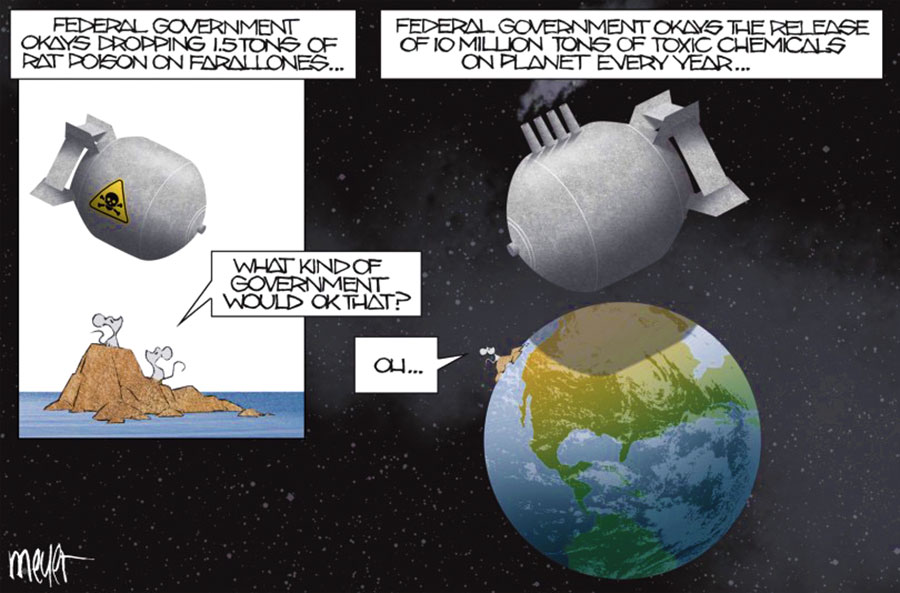Chemical warfare – on a National Marine Sanctuary
The Farallon Islands are in the Pacific Ocean, 28 miles off the coast of San Francisco, California.
Designated the Farallon Islands National Marine Sanctuary, it is in effect a predominantly underwater U.S. national park teeming with marine life. There is only one tiny research station here and the island (named from the Spanish, Farallones, meaning cliffs) and public is not allowed on the undeveloped island.
This small group of islands are a vital breeding ground for thousands of seabirds, including 12 species of seabird and shorebird who nest on the islands: western gulls, Brandt’s cormorants, pelagic cormorants, double-crested cormorants, pigeon guillemot, common murre, Cassin’s auklets, tufted puffins, black oystercatchers, rhinoceros auklets, ashy storm-petrels, and Leach’s storm-petrels.
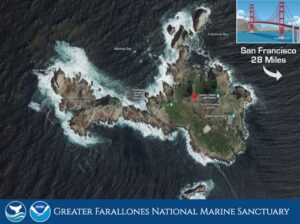 Marine mammals including sea lions, seals, blue whales and grey whales swim and feed in the surrounding waters, just off the continental shelf where upwellings attract myriad marine animals to feed.
Marine mammals including sea lions, seals, blue whales and grey whales swim and feed in the surrounding waters, just off the continental shelf where upwellings attract myriad marine animals to feed.
This haven is under imminent toxicological threat — by humans with a profit-driven plan to bombard the Southeast Farallon Island with a massive amount of toxic Brodifacoum rat poison-laced bait pellets, dropped from helicopters. The contractors hired to deliver this poisonous payload want to attempt to completely eradicate an entire population of thousands of mice — who have been living on the island for over 150 years. The mice were likely introduced by sailors in the mid-1800s.
Over the past 1.5+ centuries, the house mice on the Farallones, Mus musculus, have established an ecological niche. They are integrated into the island’s web of life and food chain. Nature adapts and evolves. The introduced mice have become a valuable diet for the thousands of birds who nest on the island. This is exactly how natural systems change, operate, adapt, and evolve. When mouse populations increased, more birds came to eat them. The mice population also fluctuates dramatically with the seasons. To call this ecosystem somehow unnatural or in need of toxicological correction ignores the science of ecology and the adatpive nature of ecosystems.
This is how natural systems work. Animals have moved organisms around the planet before homo sapiens did. Modern, technological humans have only accelerated this natural dispersion of plant and animal species. READ MORE about Invasion Biology, and the non-scientific species labels, “native” and “non-native.”
2 toxic killers: Brodifacoum & humans
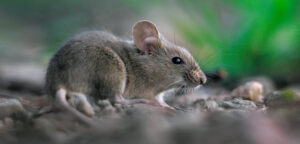
Photo: Grzegorz-Lesniewski-NIS-Minden-Pictures
The poison that will be dropped onto the Farallones is Brodifacoum, a highly toxic, 2nd-generation, anti-coagulant rat poison which inhibits blood clotting in animals who consume it, and thus causes a brutal death by internal bleedng. READ MORE about Brodifcoum.
According to Wikipedia, “Brodifacoum has an especially long half-life in the body. of up to nine months…” And, “anticoagulants cause damage to tiny blood vessels (capillaries), increasing their permeability, causing internal bleeding. These effects are gradual, developing over several days. In the final phase of the intoxication, the exhausted rodent collapses due to hemorrhagic shock…”
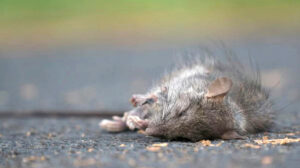
Photo: John Shick, ABC-News
A mere 1.5 oz. of Brodifacoum, just enough to fill a shot glass, is the approximate amount needed to infuse 3,500 lbs. of cereal bait with lethal toxicity for thousands of mice. But any other animal, including gulls, hawks, eagles, sea lions or seals who consume the Brodifacoum-laced cereal bait pellets, or who eats a poisoned mouse will also be poisoned.
To introduce this massive amount of Brodifacoum poison to this relatively pristine National Marine Sanctuary, the project requires approval by the U.S. Fish & Wildlife Service (USFWS). As of Sept. 2023, that approval is still pending, and not likely due before 2024. The California Coastal Commission (CCC) evaluated the poison project, since it affects coastal and marine waters — and, under great institutional pressure balked, but then granted a “conditional concurrence” in 2022, because the CCC’s conditions had not been met. Activists are concerned, once out of public scrutiny, it would likely be rubber-stamped. This regulatory body typically bows to institutional and political pressure — yet it also sometimes responds to public outrage.
You can help stop all this killing.
Share this webpage on social media. Media coverage, public awareness and public outrage can pressure politicians to stop this killing project before it begins (which may be as soon as autumn of 2023).
The majority of the public is either unaware of these ecologically reckless island poisoning campaigns, or opposes them when they learn more facts than are provided by the for-profit poison manufacturers.
Even many so-called “conservation” groups are supportive of massive poison campaigns, or at best remain silent — because of large corporate donations by chemical manufacturers like Dow or their lesser-knowlobbyist front groups. The Nature Conservancy, to name one such “conservation” group, has even officially partnered with Dow Chemical company which manufacturers these toxic chemicals.
![]() SIGN THE Change.org PETITION. Help us get from 40,000 to 50,000 signatures, making this common sense public demand one of the most popular petitions: https://www.change.org/p/formal-request-to-the-california-coastal-commission-stop-the-poison-drop-on-the-farallon-islands?signed=true
SIGN THE Change.org PETITION. Help us get from 40,000 to 50,000 signatures, making this common sense public demand one of the most popular petitions: https://www.change.org/p/formal-request-to-the-california-coastal-commission-stop-the-poison-drop-on-the-farallon-islands?signed=true
Playing God — and Grim Reaper.
The introduction of this toxic poison into the natural world, let alone into a protected marine ecosystem, let alone this much of it, is antithetical to the designation of a national sanctuary. The poison contractors even admit that some of the tens of thousands of poison bait pellets will likely end up in the ocean — and thus enter the food chain. The contractors claim, of course, that the pellets will dissolve harmlessly in the ocean. That’s if you choose to believe those who profit from poison drops and ask for your trust — yet disallow independent, 3rd party or citizen oversight, or media coverage of their operations. Nor post-drop, third-party verification.
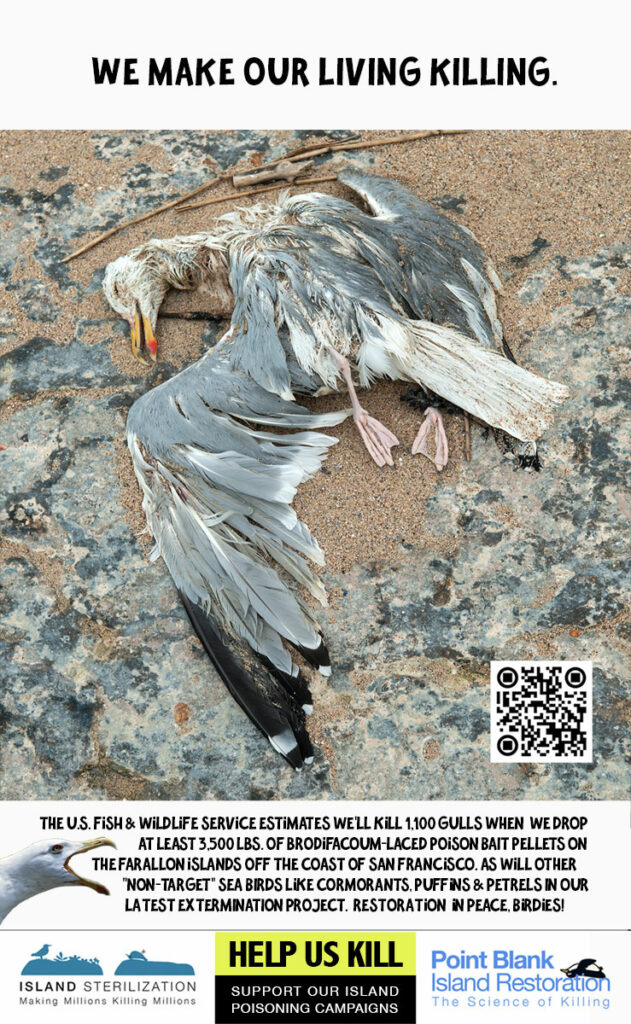
A satiric poster of the extermination business.
The U.S. Fish & Wildlife Service also estimates that approximately 1,100 Western gulls will be killed by the poisons. The industry calls this large number of incidental deaths, “by-kill.” Even though the poison project proponents claim they will try to haze away gulls and other sea birds during the helicopter drop and additional pellet-spreading by hand, gulls are expected to eat poisoned rats and then fly to the mainland where they will die, including on the San Francisco shoreline.
Even some Ashy Storm Petrels, a bird federally listed as Threatened, are expected to be killed by the Brodifacoum bombardment of the island. Petrels are the stated justification for the poison drop: about one dozen burrowing owls are purported to fly out the Farallons to eat mice, but then also eat some petrel eggs. This is the justification for a massive, multi-million dollar poisoning project.
What number of other animals, and marine mammals who frequent this marine sanctuary will also be poisoned or killed by the rat poison is anyone’s conjecture.
If at first you don’t succeed, kill, kill again.
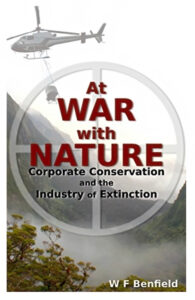 The poison contractors also acknowledge that just one helicopter drop of 3,500 lbs. of “Brody”-laced cereal bait might not work to kill every single mouse, as they admit they must. In that event, they plan an additional drop. And if mice survive the 2nd drop, they would drop poison a 3rd time.
The poison contractors also acknowledge that just one helicopter drop of 3,500 lbs. of “Brody”-laced cereal bait might not work to kill every single mouse, as they admit they must. In that event, they plan an additional drop. And if mice survive the 2nd drop, they would drop poison a 3rd time.
In the reality of this deadly, for-profit business, “success” must be achieved in order to justify continuing and expanding these island extermination programs, which are now widespread, though mostly unreported to the public. Or labeled “conservation” efforts to preclude public disgust and outrage. Australia and New Zealand, places most U.S. citizens think of as exotic, wild, untamed places, have for years been doing extensive aerial poisoning campaigns in wild areas teeming with animals, including so-called “non-target” animals.
VIDEO: New Zealand tourists reveal poison impacts – Deer and other animals poisoned by rodenticide (Sodium flouroacetate, “compound 1080” (aka, 1080) dropped from helicopters onto large areas of island national park, including into streams and forests.
60+ years of biocide warnings
Over six decades ago, scientist Rachel Carson warned the nation and world of the ecological damage these kinds of poisonous chemicals — biocides — do, in her 1962 seminal book, Silent Spring. She was vilified for her work back then because it threatened the profits of the poison manufacturers who sell their chemical wares. Since then, the problem has only intensified and spread globally. An ideology advocating killing mass numbers of both animals and plants with poisons has become more widespread and mainstream, largely by multi-million dollar public relations campaigns and lobbying federal and state governments by the chemical industry.
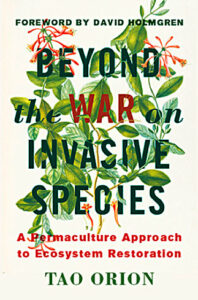 The widespread, ideological and deadly practice of demonizing, targeting and killing millions of wild plants & animals is summarized with the term “Invasion Biology.”
The widespread, ideological and deadly practice of demonizing, targeting and killing millions of wild plants & animals is summarized with the term “Invasion Biology.”
Espousing the selective extermination of entire species of plants and animals with toxic endocrine-disrupting and anti-coagulant poisons has become widespread and mainstream, largely because of multi-million dollar public relations campaigns financed by chemical industry giants including Bayer (Monsanto’s parent holding company), Dow Chemical, Syngenta and BASF.
READ MORE ABOUT INVASION BIOLOGY.
MUSIC VIDEO: There Were Some Men Out to Kill Mice
An original song — based on one you may recognize if you’re clever — shows you what’s planned for the South Farallon island — and countless animals who live on it, or in the sea or sky surrounding it. See beyond the pseudo-scientific jargon justifying profit-driven, mass nature-exterminating campaigns like this one.

